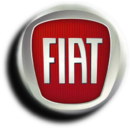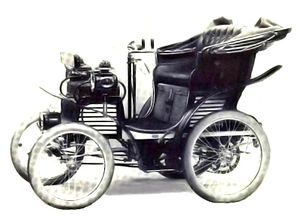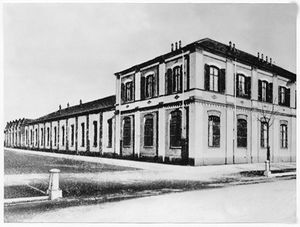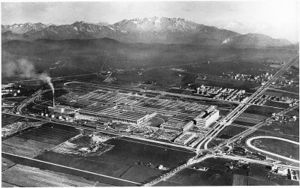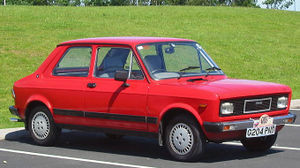Fiat
Fiat S.p.A., an acronym for Fabbrica Italiana Automobili Torino (Italian Automobile Factory of Turin), is an Italian automobile manufacturer, engine manufacturer, financial and industrial group based in Turin in the Piedmont region. Fiat was founded in 1899 by a group of investors including Giovanni Agnelli. Fiat has also manufactured railroad vehicles, tanks and aircraft. As of 2009, Fiat is the world's sixth largest carmaker as well as Italy's largest carmaker.
Fiat-based cars are constructed all around the world, with the largest number produced outside Italy being built in Brazil, where they are best-sellers. It also has factories in Argentina and Poland. Fiat has a long history of licensing its products to other countries. Joint venture operations are found in Italy, France, Turkey, India, Pakistan, China, Serbia and Russia.
Agnelli's grandson Gianni Agnelli was Fiat chairman from 1966 until 1996, and honorary chairman from then until his death on 24 January 2003, while Cesare Romiti served as chairman. After their removal, Paolo Fresco served as chairman and Paolo Cantarella as CEO. Umberto Agnelli then took over as chairman from 2002 to 2004. After Umberto Agnelli's death on 28 May 2004, Luca Cordero di Montezemolo was named chairman, but Agnelli heir John Elkann became vice chairman at age 28 and other family members are on the board. At this point, CEO Giuseppe Morchio immediately offered his resignation. Sergio Marchionne was named to replace him on 1 June 2004.
n September 2010, shareholders approved a plan to split Fiat's industrial businesses from the group. Truck manufacturer Iveco, farm gear maker CNH Global NV and the industrial part of Fiat Powertrain Technologies were demerged into a new entity, Fiat Industrial, at the beginning of 2011. Fiat Industrial has a separate listing on the Milan stock exchange beginning January 3, 2011.
History and activities
 Fiat Uno rally car |
The group's activities were initially focused on the industrial production of cars, industrial and agricultural vehicles. Over time it has diversified into many other fields, and the group now has activities in a wide range of sectors in industry and financial services. It is Italy's largest industrial concern. It also has significant worldwide operations, operating in 61 countries with 1,063 companies that employ over 223,000 people, 111,000 of whom are outside Italy. Fiat built the famous Lingotto car factory, opened in 1923.
Fiat was to make military machinery and vehicles during World War II for the Italian Army and Air Force. Fiat made fighter aircraft, which was one of the most common Italian aircraft used along with the Savoia-Marchetti, and also made light tanks and armored vehicles. These machinery were weak compared to some of the German and Soviet machinery, but were still used often.
Fiat corporation, starting from the late 1960s, has bought (or gained control of) a wide range of companies, including:
- Car companies - the long list includes well known firms like Ferrari, Lancia, Autobianchi (already bought by Lancia), Alfa Romeo, Maserati and Innocenti. Fiat also owns some brands of industrial vehicles including OM and Iveco.
- Agricultural and construction vehicles - Fiat group also owns CNH Global (which includes: Case Construction, Case IH, Flexi-Coil, Kobelco, New Holland, New Holland Construction, and Steyr); and Fiat-Hitachi Construction.
- Buses - produced with the Fiat, Iveco or Irisbus names.
- Aviation - aircraft and related components were produce by FiatAvio (now Avio, an independent company), which also controls EVL, a space industry.
- Military vehicles, see Ariete
- Vehicle components - the major Italian component maker Magneti-Marelli is owned by Fiat, and in turn owns the other brands Carello, Automotive Lighting, Siem, Cofap, Jaeger, Solex, Veglia Borletti, Vitaloni and Weber; other accessory brands include Riv-Skf and Brazilian Cofap.
- Steelmaking and metallurgy - Fiat owns Teksid and produces machines for the industry (also for car factories) with Comau (now Comau Systems), which bought the American Pico, Renault Automation and Sciaky.
- Publishing - notably, Fiat group also owns important editorial brands, like La Stampa (created in 1926 for the famous newspaper), Itedi, Italiana Edizioni. Some national and local newspapers are owned or otherwise controlled by the different companies. A specialised advertising space reseller is Publikompass, supported by the Consorzio Fiat Media Center.
- Financial services - An important insurance company, Toro Assicurazioni, allows Fiat to control a relevant part of this market (also with minor companies like Lloyd Italico, Augusta Assicurazioni) and to interact with some associated banks.
- Construction - Ingest Facility and Fiat Engineering work in various fields of construction, while IPI is a mediation company that also deals with the management of real estate properties.
- Information technology - Fiat is present in IT fields and in communications with ICT - Information & Communication Technology, Espin, Global Value, TeleClient, Atlanet.
- Leisure The group owns the Sestriere skiing facilities (being this village on Alps a creation of Agnelli family).
In the 1970s and 1980s, the company became a pioneer in the use of industrial robotics for the assembly of motor vehicles. Fiat assembly plants are among the most automated and advanced in the world.
- Other services Fiat Gesco, KeyG Consulting, Sadi Customs Services, Easy Drive, RM Risk Management and Servizio Titoli are minor companies that work for public services, delivering services in economics and financial fields.
Other activities include industrial securitisation (Consorzio Sirio), treasury (Fiat Geva), Fiat Information & Communication Services.
Fiat supports the Fondazione Giovanni Agnelli, an important foundation for social and economic research. Palazzo Grassi, a famous ancient building in Venice, now a museum and formerly supported by Fiat, was eventually sold to the Venice casino in January 2005.
Fiat has recently begun sponsoring the Jamaican bobsledding team and promoting this sponsorship through commercials. Many like Jamaican athletes because they see them as underdogs and as people who enjoy life. While Volvo sponsors golf, Mercedes tennis, and Hyundai soccer, Fiat is trying to look unique and more light-hearted. Further, the team is relatively cheap to sponsor.
The group is present in many countries, not only in the West. Notably, it was one of the first companies to build factories in Soviet-controlled countries, with the best known examples in Vladivostok, Kyiv and Togliattigrad. The Russian government later continued the joint venture under the name AutoVAZ (known as Lada outside the former USSR). The venture was most notable for the Lada Riva. Fiat also has a subsidiary in Poland at Tychy, (formerly called FSM) where Fiat's small cars (the 126, Cinquecento and now Seicento) are made. Fiat also has factories in Argentina, Brazil, and Italy. In addition, its cars are produced through licensing and joint-venture agreements in China, Egypt, France, India, South Africa, Turkey, and Vietnam. Local variants of Fiats are produced at these factories as well as a world car, the Palio. As of 2005, the company holds the first position in the Brazilian automobile market with a market share close to 25%.
Fiat has articulated that it wishes to focus on expanding into third-world markets because, in the words of former chairman Paolo Fresco, “those are the only markets where you can expect growth." And it is true that Fiat’s specialization in smaller cars puts it at an advantage in those markets, but cars sold in third-world countries tend to be much simpler than those sold elsewhere (e.g., most lack air conditioning), and thus require much less money to develop.
After Fiat ceased importing cars into the United States in 1984,and Australia in 1989 however, they continued to be imported into Canada, as did Soviet versions of Fiat models.
History
Giovanni Agnelli founded Fiat in 1899 with several investors and led the company until his death in 1945, while Vittorio Valletta administered the day-to-day activities of the company. Its first car the 3 ½ CV (of which only eight copies were built, all bodied by Alessio of Turin) strongly resembled contemporary Benz, and had a 697cc boxer twin engine. In 1903, Fiat produced its first truck. In 1908, the first Fiat was exported to the US. That same year, the first Fiat aircraft engine was produced. Also around the same time, Fiat taxis became somewhat popular in Europe. By 1910, Fiat was the largest automotive company in Italy — a position it has retained since. That same year, a plant licensed to produce Fiats in Poughkeepsie, NY, made its first car. This was before the introduction of Ford's assembly line in 1913. Owning a Fiat at that time was a sign of distinction. A Fiat sold in the U.S. cost between $3,600 and $8,600, compared to US$825 the Model T in 1908.
Upon the entry of the U.S. into World War I in 1917, the factory was shut down as U.S. regulations became too burdensome. At the same time, Fiat had to devote all of its factories to supplying the Allies with aircraft, engines, machine guns, trucks, and ambulances. After the war, Fiat introduced its first tractor, the 702. By the early 1920s, Fiat had a market share in Italy of 80%.
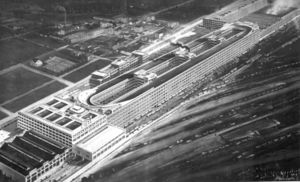
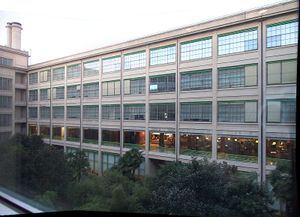
In 1921, workers seized Fiat's plants and hoisted the red flag of communism over them. Agnelli responded by quitting the company. However, the Italian Socialist Party and its ally organization, the General Confederation of Labor, in an effort to effect a compromise with the centrist parties ordered the occupation ended. In 1922, Fiat began to build the famous Lingotto car factory — the largest in Europe up to that time — which opened in 1923. It was the first Fiat factory to use assembly lines; by 1925, Fiat controlled 87% of the Italian car market. In 1928, with the 509, Fiat included insurance in the purchase price.
Fiat made military machinery and vehicles during World War II for the Army and Regia Aeronautica and later for the Germans. Fiat made obsolete fighter aircraft like the biplane CR.42, which was one of the most common Italian aircraft, along with Savoia-Marchettis, as well as light tanks (obsolete compared to their German and Soviet counterparts) and armored vehicles. The best Fiat aircraft was the G.55 fighter, which arrived too late and in too limited numbers. In 1945 — the year Mussolini was overthrown — the Italian Committee of National Liberation removed the Agnelli family from leadership roles in Fiat because of its ties to Mussolini's government. These were not returned until 1963, when Giovanni's grandson, Gianni , took over as general manager until 1966, as chairman until 1996.
Gianni Agnelli
Among Gianni's first steps after he gained control of Fiat was a massive reorganization of the company management, which had previously been highly centralized, with almost no provision for the delegation of authority and decision-making power. Such a system had worked effectively enough in the past but lacked the responsiveness and flexibility made necessary by Fiat's steady expansion and the growth of its international operations in the 1960's. The company was reorganized on a product-line basis, with two main product groups--one for passenger cars, the other for trucks and tractors--and a number of semi-independent division and subsidiaries. Top management, freed from responsibility for day-by-day operations of the company, was able to devote its efforts to more far-reaching goals. In 1967, FIAT made its first acquisition when it purchased Autobianchi. Then, in 1969, it purchased controlling interests in Ferrari and Lancia. According to Newsweek in 1968, FIAT was “the most dynamic automaker in Europe . . . [and] may come closest to challenging the worldwide supremacy of Detroit." In 1967 Fiat, with sales amounting to $1.7 billion, outstripped Volkswagen, its main European competitor; in 1968 Fiat produced some 1,750,000 vehicles while its sales volume climbed to $2.1 billion ($11.5 billion today). At the time, Fiat was a conglomerate, owning Alitalia Airlines, toll highways, typewriter and office machine manufacturer, electronics and electrical equipment firms, a paint company, a civil engineering firm, and an international construction company. That same year, Fiat acquired Citroën--one of France’s three major automakers at the time. However, in 1976, it sold the company. Following up on an agreement that Valetta had made with Soviet officials in 1966, Agnelli constructed a Fiat plant in the new city of Togliattigrad on the Volga that went into operation in 1970. On his initiative, Fiat automobile and truck plants were also constructed in industrial centers of Yugoslavia, Poland, Bulgaria, and Romania. In 1979, the company became a holding company when it spun off its various businesses into autonomous companies, one of them being Fiat Auto. That same year, sales reached an all-time high in the United States, corresponding to the Iranian Oil Crisis. However, when gas prices fell again after 1981, Americans began purchasing sport utility vehicles, minivans, and pickup trucks in larger numbers (marking a departure from their past preference for large cars). Also, Japanese automakers had been taking an ever-larger share of the car market, increasing at more than half a percent a year.
Thus, in 1984, Fiat and Lancia withdrew from the American market. In 1989, it did the same in the Australian market.
In 1986, Fiat acquired Alfa Romeo from the Italian government. In 1992, two top corporate officials in the Fiat Group were arrested for political corruption. A year later, Fiat acquired Maserati. In 1995 Alfa Romeo exited the US market. Maserati re-entered the US market under Fiat in 2002. Since then, Maserati sales there have been increasing briskly.
Paolo Fresco
Paolo Fresco was brought in as chairman of Fiat in 1998. The hope was that the veteran of General Electric would bring more of an emphasis on shareholder value to Fiat. By the time he took power, Fiat's market share in Italy had fallen to around 41% from around 62% in 1984. However, a John Welch-like management style would be much harsher than that used by the Italians (e.g., precarious versus lifetime employment). Instead, Fresco focused on offering more incentives for good performance, including compensation using stock options for top and middle management. However, his efforts were frustrated by union objections. Unions insisted that pay raises be set by length of tenure, rather than performance. Another conflict was over his preference for informality (the founder, Giovanni Agnelli, used to be a cavalry officer). He often referred to other managers by their first name, although company tradition obliged one to refer to others using their titles (e.g., "Chairman Fresco"). The CEO of the company, Managing Director Paolo Cantarella, ran the day-to-day affairs of the company, while Fresco determined company strategy and especially acted as a negotiator for the company. In fact, many speculated the main reason he was chosen for the job was to sell Fiat Auto (although Fresco fervently denied it). In 1999, Fiat formed CNH Global by merging New Holland NV and Case Corporation.
Gianni Agnelli
Among Gianni's first steps after he gained control of Fiat was a massive reorganization of the company management, which had previously been highly centralized, with almost no provision for the delegation of authority and decision-making power. Such a system had worked effectively enough in the past but lacked the responsiveness and flexibility made necessary by Fiat's steady expansion and the growth of its international operations in the 1960's. The company was reorganized on a product-line basis, with two main product groups--one for passenger cars, the other for trucks and tractors--and a number of semi-independent division and subsidiaries. Top management, freed from responsibility for day-by-day operations of the company, was able to devote its efforts to more far-reaching goals. In 1967, FIAT made its first acquisition when it purchased Autobianchi. Then, in 1969, it purchased controlling interests in Ferrari and Lancia. According to Newsweek in 1968, FIAT was “the most dynamic automaker in Europe . . . [and] may come closest to challenging the worldwide supremacy of Detroit." In 1967 Fiat, with sales amounting to $1.7 billion, outstripped Volkswagen, its main European competitor; in 1968 Fiat produced some 1,750,000 vehicles while its sales volume climbed to $2.1 billion ($11.5 billion today). At the time, Fiat was a conglomerate, owning Alitalia Airlines, toll highways, typewriter and office machine manufacturer, electronics and electrical equipment firms, a paint company, a civil engineering firm, and an international construction company. That same year, Fiat acquired Citroën--one of France’s three major automakers at the time. However, in 1976, it sold the company. Following up on an agreement that Valetta had made with Soviet officials in 1966, Agnelli constructed a Fiat plant in the new city of Togliattigrad on the Volga that went into operation in 1970. On his initiative, Fiat automobile and truck plants were also constructed in industrial centers of Yugoslavia, Poland, Bulgaria, and Romania. In 1979, the company became a holding company when it spun off its various businesses into autonomous companies, one of them being Fiat Auto. That same year, sales reached an all-time high in the United States, corresponding to the Iranian Oil Crisis. However, when gas prices fell again after 1981, Americans began purchasing sport utility vehicles, minivans, and pickup trucks in larger numbers (marking a departure from their past preference for large cars). Also, Japanese automakers had been taking an ever-larger share of the car market, increasing at more than half a percent a year.
Thus, in 1984, Fiat and Lancia withdrew from the American market. In 1989, it did the same in the Australian market.
In 1986, Fiat acquired Alfa Romeo from the Italian government. In 1992, two top corporate officials in the Fiat Group were arrested for political corruption. A year later, Fiat acquired Maserati. In 1995 Alfa Romeo exited the US market. Maserati re-entered the US market under Fiat in 2002. Since then, Maserati sales there have been increasing briskly.
Paolo Fresco
Paolo Fresco was brought in as chairman of Fiat in 1998. The hope was that the veteran of General Electric would bring more of an emphasis on shareholder value to Fiat. By the time he took power, Fiat's market share in Italy had fallen to around 41% from around 62% in 1984. However, a John Welch-like management style would be much harsher than that used by the Italians (e.g., precarious versus lifetime employment). Instead, Fresco focused on offering more incentives for good performance, including compensation using stock options for top and middle management. However, his efforts were frustrated by union objections. Unions insisted that pay raises be set by length of tenure, rather than performance. Another conflict was over his preference for informality (the founder, Giovanni Agnelli, used to be a cavalry officer). He often referred to other managers by their first name, although company tradition obliged one to refer to others using their titles (e.g., "Chairman Fresco"). The CEO of the company, Managing Director Paolo Cantarella, ran the day-to-day affairs of the company, while Fresco determined company strategy and especially acted as a negotiator for the company. In fact, many speculated the main reason he was chosen for the job was to sell Fiat Auto (although Fresco fervently denied it). In 1999, Fiat formed CNH Global by merging New Holland NV and Case Corporation.
Partnership with GM
Over time, most automotive companies around the world have become holding companies of foreign as well as domestic competitors. For example, General Motors owned a controlling interest in Saab Automobile and, until recently, in Isuzu. Fresco signed a joint-venture agreement in 2000 under which GM acquired a stake in Fiat Auto. This made it appear as if Fiat was next, although GM has made joint ventures with other companies (such as Toyota) without acquiring them. Nevertheless, Fiat did not see the GM partnership as a threat, rather as an opportunity to off-load its automotive business. The agreement with GM included a put option, which held that Fiat would have the right to sell GM its auto division after four years at fair market value. If GM balked, it would be forced to pay a penalty of $2 billion. When Fiat tried to sell GM the company, GM chose the penalty. On 13 May 2005 GM and Fiat officially dissolved their agreement.
The current CEO however views alliances such as these as the deciding factor of the future success of Fiat. In 2005 Fiat was courting Ford.
As part of the recent divestitures, in 2003 Fiat shed its insurance sector, which it was operating through Toro Assicurazioni to the DeAgostini Group. In the same year, Fiat sold its aviation business, FiatAvio to Avio Holding. In February 2004, the company sold its interest in Fiat Engineering, as well as its stake in Edison.
Fiat faces a multitude of threats, including rising steel prices (up by 16-30% beginning of 2008), a strong Euro, and increased competition from Japanese and South Korean car manufacturers in Europe. Although the light-vehicle market share of Japanese and South Korean automakers in Europe is less than in the U.S. (12.5% and 3.9%, respectively versus 30% and 3.9% in the US), it has been increasing steadily at about a half a percent a year.
Fiat has drawn criticism within New Zealand for an advertisement it ran in Italy, which a New Zealand Ministry of Foreign Affairs and Trade spokesman described as "culturally insensitive and inappropriate". The advert showed women performing the haka beside the new Fiat car and crowd noise is in the background to simulate the atmosphere in an All Blacks rugby union match. As the haka is finished a woman drives away in the Fiat car and a boy in the back of the car pokes out his tongue, which is the action used to finish the haka.
Potential takeover of GM Europe
Template:Main In April and May 2009, the possibility of a take over of GM Europe, a subsidiary of General Motors, was being discussed between the two companies. GM Europe owns Opel/Vauxhall and Saab.
On May 30, 2009, German officials named Magna International, a Canadian-Austro car parts manufacturer, to take over Opel. The Opel/Vauxhall partnership is the largest of GM Europe's operations.
As of June 2010, the deal fell through and General Motors is holding on to Opel/Vauxhall and sold Saab to Spyker.
Enterprises outside of Italy
Fiat was a key player in developing motor industries for a number of countries from the 1950s, particularly in Eastern Europe, Spain, Egypt, Ethiopia and Turkey. The AutoVAZ state works Lada products in Tolyatti (Togliatti), Russia, were Fiat based, as were SEAT products of Spain. Lada now is controlled by Renault, and SEAT by Volkswagen. A small number of Fiats were also constructed in Bulgaria.
Zastava, Serbia
Its first enterprise came in 1955, when it agreed a deal with Yugoslav carmaker Zastava to assemble Fiats for Eastern Europe. The first cars to be produced by Zastava were its versions of the Fiat 1300 and Fiat 1400. By 1970, Zastava was producing parts for the newer Fiat 124 and Fiat 125 models, although these cars were actually assembled in Poland. The Zastava 750, launched in 1962, was Zastava's version of the iconic Fiat 600 minicar. It outlived the car on which it was based, with production not finishing until 1981.
Zastavas were not popular outside of Eastern Europe before the 1980s, although they were exported to the United States under the Yugo brand as long ago as 1973.
The most famous product launched by Zastava is the Zastava 101, a front-wheel drive car based on the Fiat 128, also available as a hatchback version never sold in Italy. Despite numerous bad press about build quality and reliability, it sold well in Yugoslavia thanks largely to its low asking price, cheap maintenance costs and simple mechanical design.
With the demise of the aged Zastava 750 in 1981, the minicar gap in the Zastava range was filled by the Zastava Koral, which was best known in Britain and America as the Yugo Tempo. It was based on the 1971 Fiat 127, which was due to be replaced by the Fiat Uno in 1983. It was among the cheapest cars on sale in both countries, and it was well received in its class in Britain, but not so much in the more competitive U.S. market. But hostility towards Yugoslavia in the wake of the 1992 civil unrest saw a swift ceasure of imports to both Britain and America.
The Zastava factory in Kragujevac was later bombed, but was rebuilt once the war was over, and production continued at another factory in Kragujevac.
In 1987, Zastava came up with a new car design. The Zastava Florida - known in other markets as the Yugo Sana - was styled by Giorgetto Giugiaro at the ItalDesign studio, featured a range of refined Peugeot engines, and was mechanically similar to the forthcoming and highly acclaimed Fiat Tipo. It was sold in Britain from 1988 to 1992, but was withdrawn from sale for a number of reasons — particularly the domestic upheavels in Yugoslavia and the fall in popularity of the whole Yugo range in Britain. Sales continued in its homeland, with an update at the end of the 1990s.
Zastava did not launch another new car for another 16 years. The 2003 Zastava 10 model was another Fiat design — this time the second generation Punto. It boasts similar features to the Punto and other cars in its class such as the Volkswagen Polo. It is competitively priced compared to other similar-sized cars, including the Punto on which it is based.
Four years after its launch, the Zastava 10 has not yet been sold outside of the former Yugoslavia.
According to Fiat sources a new memorandum of understanding between Fiat and the Serb ministry of economic and regional development about the acquisition of Zastava's Kragujevac plant foresees a new company being set up in which the Italians would have a 70 percent stake and the Serb government 30 percent. Several models are to be introduced to the plant once its upgrade is complete, including possibly the Fiat 500 and the new low cost vehicle that Fiat is introducing to compete with Renault's Dacia brand.
Polski Fiat/FSO (Poland)
Fiat automobiles have been made in Poland since 1920. In 1932, the Polskie zakłady Inżynieryjne (Polish Engineering Works, PZInż) started the production of Fiat 508, produced until 1939 also as a military vehicle. In 1936 the licence was extended to include the Fiat 518 model. In 1965, the Polish communist government signed a deal with Fiat to produce selected Fiat models in Poland at the FSO factory in Warsaw that had been built in 1951. Production of the new car — the Polski Fiat 125p - began in 1967. It was visually identical to the Fiat 125, but it made use of older Fiat mechanicals which dated back to 1960. The car sold very well in its homeland and was soon exported to Western Europe. After 1979, Fiat withdrew control of the FSO factory, and from then on the FSO badge was revived. A year earlier, it had appeared on a new five-door hatchback, the FSO Polonez, that made use of Fiat 125 running gear.
The Polski Fiat design survived until 1991, by which time almost 1,500,000 had been made in less than 25 years. It was a cheap competitor to similar Eastern European budget cars, and by the time of its demise, many Eastern European carmakers were adopting modern Western style designs in place of the archaic three-box saloons that had barely moved out of the 1960s.
FSO was taken over by Daewoo of South Korea in 1995, by which time the FSO Polonez had been replaced by the Caro, which was little more than a facelift of the 1978 design with underpinnings dating back to 1960. This car was sold in Western Europe until the end of the 1990s, and production finally finished in 2002.
FSO had become independent again in late 2000, after Daewoo went bankrupt and were saved by General Motors. Despite this, FSO continued to build versions of the Daewoo Matiz and Daewoo Lanos. These cars remain in production to this day, although the target of the factory is to focus on the production of the Chevrolet Aveo which has already been introduced.
The Fabryka Samochodów Małolitrażowych (FSM) in Bielsko-Biała and Tychy started the output of the Fiat 126(p) in 1983 and the Cinquecento (see Fiat Cinquecento)in 1991.
In 1992 90% of stock of FSM (Fiat Auto Poland, since 1993) was purchased by Fiat Auto. since then it produced Cinquecento, Uno, Seicento, Siena and Palio Weekend (see Fiat Cinquecento, Fiat Uno, Fiat Seicento, Fiat Siena and Fiat Palio Weekend) models with the capacity up to 200.000 cars a year. In 2003, FSM become the sole producer of Fiat Panda, and in 2007 of new Fiat 500 model. The capacity was increased to ca. 280.000 cars a year, and due to new investments in 2006-2007 will reach over half a million in 2008. This will enable Fiat Auto Poland to include a new model of Ford in its production. It is worth noting both Panda and 500 were selected European car of the year, respectively in 2004 and 2007.
Other Fiat investment in Poland is a joint Fiat-GM venture of Powertrain, producing multijet (see JTD engine) car engines both for Fiat and GM models.
AutoVAZ Lada (Soviet Union/Russia)
In 1966, Fiat helped U.S.S.R. state industries build a new car factory (AvtoVAZ) on the banks of the Volga river. A planned city called Tolyatti (named after Palmiro Togliatti,an Italian communist) was developed around the factory, which started producing a "people's car" similar to the Volkswagen Beetle and Citroën 2CV of Germany and France. The new Soviet car, called the Lada, however, was a more spacious offering, in four-door saloon and five-door estate variants. Fiat installed British-built machine tools supplied by Herbert-BSA[1] of Birmingham for the manufacture of many Lada parts. The 124's design was mechanically upgraded to survive treacherous Russian driving conditions and extremely cold winters. Imports to Western Europe, Canada, and other third world countries began, and by the early 1980s, the cars began to sell fairly well thanks largely to their low asking price. This car was upgraded to become the Lada Riva (marketing name in some markets) in 1980.
In 1977 the four-wheel drive Lada Niva was introduced which used some proprietary Fiat based components from the car (eg engine and gearbox), but the body and four-wheel drive system were VAZ designs. Off the road there were few vehicles that could match it. The Riva and Niva are still in production today (2008).
In June 2008, Fiat and Severstal's Sollers JSC have formalised a number of joint ventures announced last year to make and sell Fiat cars and engines in Russia. They will make up to 90,000 diesel engines and up to 50,000 Fiat Linea sedans a year. Production will begin this year (2008).
Bulgaria
1967-1971 produced Pirin-Fiat in Lovech, Bulgaria.
Turkey
In Turkey, the Fiat 124 was produced under licence by Tofaş as the Tofaş Murat. This was replaced by a version of the Fiat 131, known as the Tofaş Şahin. Today the Fiat Linea car is amongst those manufactured by the Fiat-Tofas joint venture in Turkey, and the company has about 10% of the Turkish car market as of 2008.
Spain
in Spain, SEAT was set up with Fiat assistance, producing Fiat models under its own brand name until 1981, when Fiat withdrew its support. However, production of the Fiat-based models continued, with the final Fiat-based SEAT (the Marbella) not finishing until 1996. By this stage, SEAT had become part of German manufacturer Volkswagen after several years of ownership by the Spanish government.
South Africa
In South Africa, the Fiat Uno was assembled under licence by Nissan, which marketed it through its dealerships as the Uno, without Fiat branding.
Ethiopia
the Fiat 131, known as the Holland Car DOCC.
Helwan, Egypt
As part of Nasser's regime he made a way to protect the national economy, he ordered EGID (General Intelligence Agent) to establish Nasr. Producing some Fiat models, then is formed with Turkey new models now which called Şahin till now El Nasr Product Fiat 128 and Şahin.
India
Premier Automobiles Limited is a Mumbai-based manufacturer of vehicles founded in 1944. In 1951, the company began producing versions of the Fiat 500 for the Indian market. This was followed by the Fiat 1100 in 1954. In 1973, the Premier name was used on its vehicles for the first time, the Premier President, based on the Fiat 1100 as Premier Padmini. In 1984, they launched the Fiat 124-based Premier 118 and 138D models.
Fiat India Automobiles Private Limited (FIAPL) is a joint venture between Fiat and Tata Motors. It was founded in 1997. Fiat builds the Palio Stile and Palio Stile Multijet in India and imports its Fiat 500 into India from Italy, whereas Fiat has many cars under its hood planned for India like the internationally acclaimed Linea, Grande Punto and Bravo, of which the Linea will release in January 2009 and the Punto and Bravo will follow in mid 2009. The Fiat plant is situated in Ranjangaon near Pune in Maharashtra and also manufactures the Tata Indica.
Sri Lanka
In 1964-65, the Ceylon Transport Board contemplated production of buses in Sri Lanka in collaboration with FIAT. However, with the change of Government in 1965, the CTB opted for a deal with British Leyland.
In 1973, entrepreneur Upali Wijewardena's Upali Motor Company began assembly of the so-called 'Upali-FIAT' 128. However, production ended with the introduction of the open-market economy in 1978.
Fiat Car Model Description and Photos
List of Fiat models since 1899
| Fiat car timeline, European market, 1899s-1949s Next -> | ||||||||||||||||||||||||||||||||||||||||||||||||||||
|---|---|---|---|---|---|---|---|---|---|---|---|---|---|---|---|---|---|---|---|---|---|---|---|---|---|---|---|---|---|---|---|---|---|---|---|---|---|---|---|---|---|---|---|---|---|---|---|---|---|---|---|---|
| Type | 1890s | 1900s | 1910s | 1920s | 1930s | 1940s | ||||||||||||||||||||||||||||||||||||||||||||||
| 8 | 9 | 0 | 1 | 2 | 3 | 4 | 5 | 6 | 7 | 8 | 9 | 0 | 1 | 2 | 3 | 4 | 5 | 6 | 7 | 8 | 9 | 0 | 1 | 2 | 3 | 4 | 5 | 6 | 7 | 8 | 9 | 0 | 1 | 2 | 3 | 4 | 5 | 6 | 7 | 8 | 9 | 0 | 1 | 2 | 3 | 4 | 5 | 6 | 7 | 8 | 9 | |
| City car | 3,5 HP | 500 A / 500 B (Topolino) ... | ||||||||||||||||||||||||||||||||||||||||||||||||||
| Small family car | 6 HP 8 HP 10 HP |
509 / 509 S | 508 (Ballila) | Ballila 1100 A / B ... | ||||||||||||||||||||||||||||||||||||||||||||||||
| Family car | 1 | 1A / Zero | 70 | 501 / 501 S / 502 / 503 | 514 / 515 | 1500 | ||||||||||||||||||||||||||||||||||||||||||||||
| Large family car | Brevetti | 2 | 2B | 505 | 507 | 518 | ||||||||||||||||||||||||||||||||||||||||||||||
| 12 HP / 16-20 HP / 16-24 HP | 15-25 HP Brevetti | 520 / 521 | 522 / 524 | 527 | 2800 | |||||||||||||||||||||||||||||||||||||||||||||||
| Executive car | 20-30 HP | 3 | 3A / 3Ter | 510 | 512 | 525 / 525 S | ||||||||||||||||||||||||||||||||||||||||||||||
| 24-32 HP / 60 HP | 28-40 HP / 30-45 HP / 50 HP | 4 / 5 / 6 | 520 "Superfiat" | 519 / 519 S | ||||||||||||||||||||||||||||||||||||||||||||||||
| Race car | ||||||||||||||||||||||||||||||||||||||||||||||||||||
| 130 HP Corsa | ||||||||||||||||||||||||||||||||||||||||||||||||||||
| <- Older Models | Fiat car timeline, European market, 1920s-1960s | Next -> | ||||||||||||||||||||||||||||||||||||||||||||||||||
| Type | 1920s | 1930s | 1940s | 1950s | 1960s | |||||||||||||||||||||||||||||||||||||||||||||
| 0 | 1 | 2 | 3 | 4 | 5 | 6 | 7 | 8 | 9 | 0 | 1 | 2 | 3 | 4 | 5 | 6 | 7 | 8 | 9 | 0 | 1 | 2 | 3 | 4 | 5 | 6 | 7 | 8 | 9 | 0 | 1 | 2 | 3 | 4 | 5 | 6 | 7 | 8 | 9 | 0 | 1 | 2 | 3 | 4 | 5 | 6 | 7 | 8 | 9 | |
| City car | Fiat 500 | |||||||||||||||||||||||||||||||||||||||||||||||||
| 500 Topolino | 600 | |||||||||||||||||||||||||||||||||||||||||||||||||
| 509 | 508 Balilla | 1100 Balilla | 850 | |||||||||||||||||||||||||||||||||||||||||||||||
| Small family car | 1100 / 1200 | 124 | ||||||||||||||||||||||||||||||||||||||||||||||||
| 501 / 502 | 503 | 514 | 515 | 1500 | 1400 | 1300 / 1500 | 125 | |||||||||||||||||||||||||||||||||||||||||||
| 518 Ardita | 1900 | |||||||||||||||||||||||||||||||||||||||||||||||||
| Large family car | 505 | 507 | 520 | 521 | 522 | 527 | 1800 / 2100 | |||||||||||||||||||||||||||||||||||||||||||
| 510 | 512 | 525 | 524 | 2800 | 2300 | 130 | ||||||||||||||||||||||||||||||||||||||||||||
| 519 | ||||||||||||||||||||||||||||||||||||||||||||||||||
| Luxury car | 520 | |||||||||||||||||||||||||||||||||||||||||||||||||
| Sports car | 8V | Trasformabile | Dino | |||||||||||||||||||||||||||||||||||||||||||||||
| MPV | 600 Multipla | 850 Familiale | ||||||||||||||||||||||||||||||||||||||||||||||||
| SUV | Campagnola | |||||||||||||||||||||||||||||||||||||||||||||||||
| <- Previous Fiat car timeline, European market, 1960s-1980s Next -> | ||||||||||||||||||||||||||||||||||||||||||||||||||
|---|---|---|---|---|---|---|---|---|---|---|---|---|---|---|---|---|---|---|---|---|---|---|---|---|---|---|---|---|---|---|---|---|---|---|---|---|---|---|---|---|---|---|---|---|---|---|---|---|---|---|
| Type | 1960s | 1970s | 1980s | |||||||||||||||||||||||||||||||||||||||||||||||
| 0 | 1 | 2 | 3 | 4 | 5 | 6 | 7 | 8 | 9 | 0 | 1 | 2 | 3 | 4 | 5 | 6 | 7 | 8 | 9 | 0 | 1 | 2 | 3 | 4 | 5 | 6 | 7 | 8 | 9 | |||||||||||||||||||||
| City car | 500 | 126 | ||||||||||||||||||||||||||||||||||||||||||||||||
| 600 | 133 | Panda | ||||||||||||||||||||||||||||||||||||||||||||||||
| Supermini | 850 | 127 | Uno | |||||||||||||||||||||||||||||||||||||||||||||||
| Small family car | 1100 | 128 | Ritmo | Tipo | ||||||||||||||||||||||||||||||||||||||||||||||
| 1300 | 124 | 131 | Regata | |||||||||||||||||||||||||||||||||||||||||||||||
| Large family car | 1500 | 125 | 132 | Argenta | Croma I | |||||||||||||||||||||||||||||||||||||||||||||
| Executive car | 2300 | 130 | ||||||||||||||||||||||||||||||||||||||||||||||||
| Coupé / Roadster | Dino / 124 Sport Spider | 124 Sport Spider | ||||||||||||||||||||||||||||||||||||||||||||||||
| 124 Coupé | ||||||||||||||||||||||||||||||||||||||||||||||||||
| Sports car | 850 Spider | X1/9 | ||||||||||||||||||||||||||||||||||||||||||||||||
| Panel van | Fiorino I | Fiorino II | ||||||||||||||||||||||||||||||||||||||||||||||||
| Compact MPV | 600 Multipla | |||||||||||||||||||||||||||||||||||||||||||||||||
| Van | 600 T | 850 T | 900 T | |||||||||||||||||||||||||||||||||||||||||||||||
| 1100 BLR / ELR / I / T | 238 | |||||||||||||||||||||||||||||||||||||||||||||||||
| 241 | 242 | |||||||||||||||||||||||||||||||||||||||||||||||||
| Daily* | ||||||||||||||||||||||||||||||||||||||||||||||||||
| Ducato I | ||||||||||||||||||||||||||||||||||||||||||||||||||
| Off-road | Campagnola (1101) | Campagnola (1107) | ||||||||||||||||||||||||||||||||||||||||||||||||
| *Rebadged Iveco model | ||||||||||||||||||||||||||||||||||||||||||||||||||
| <- Older Models | Fiat car timeline, European market, 1980s - present | |||||||||||||||||||||||||||||||||||||||
| Type | 1980s | 1990s | 2000s | 2010s | ||||||||||||||||||||||||||||||||||||
| 0 | 1 | 2 | 3 | 4 | 5 | 6 | 7 | 8 | 9 | 0 | 1 | 2 | 3 | 4 | 5 | 6 | 7 | 8 | 9 | 0 | 1 | 2 | 3 | 4 | 5 | 6 | 7 | 8 | 9 | 0 | 1 | 2 | 3 | 4 | 5 | |||||
| City cars | 126 | Cinquecento | Seicento (1998-2005) / 600 (2005-2010) | |||||||||||||||||||||||||||||||||||||
| 500 | ||||||||||||||||||||||||||||||||||||||||
| Panda I | Panda II | |||||||||||||||||||||||||||||||||||||||
| Supermini | 127 | Uno | Punto I | Punto II | ||||||||||||||||||||||||||||||||||||
| Grande Punto | Punto Evo | |||||||||||||||||||||||||||||||||||||||
| Small family car |
Ritmo | Tipo | Bravo / Brava | Stilo | Bravo II | |||||||||||||||||||||||||||||||||||
| 131 | Regata | Tempra | Marea | Linea | ||||||||||||||||||||||||||||||||||||
| Albea | ||||||||||||||||||||||||||||||||||||||||
| Large family car | 132 | Argenta | Croma I | Croma II | ||||||||||||||||||||||||||||||||||||
| Coupé | Coupé | |||||||||||||||||||||||||||||||||||||||
| Roadster | 124 Spider | Barchetta | Barchetta | |||||||||||||||||||||||||||||||||||||
| Sports car | X1/9 | |||||||||||||||||||||||||||||||||||||||
| Panel van/Leisure activity vehicle | Fiorino I | Fiorino II | Fiorino III | |||||||||||||||||||||||||||||||||||||
| Doblò | ||||||||||||||||||||||||||||||||||||||||
| Mini SUV | Sedici | |||||||||||||||||||||||||||||||||||||||
| Mini MPV | Idea | |||||||||||||||||||||||||||||||||||||||
| Compact MPV | Multipla | |||||||||||||||||||||||||||||||||||||||
| Large MPV | Ulysse I | Ulysse II | ||||||||||||||||||||||||||||||||||||||
| Van | Daily* | Scudo I | Scudo II | |||||||||||||||||||||||||||||||||||||
| Ducato I | Ducato II | Ducato III | ||||||||||||||||||||||||||||||||||||||
| Mini Pickup | Strada | |||||||||||||||||||||||||||||||||||||||
| Off-road | Campagnola (1107) | |||||||||||||||||||||||||||||||||||||||
| *Rebadged Iveco model | ||||||||||||||||||||||||||||||||||||||||
European Car of the Year Awards
Fiat cars have won the European Car of the Year Award 8 times
- 1967: Fiat 124
- 1970: Fiat 128
- 1972: Fiat 127
- 1984: Fiat Uno
- 1989: Fiat Tipo
- 1995: Fiat Punto
- 1996: Fiat Brava/Bravo
- 2004: Fiat Panda (New)
Concept Cars and Designs
Concept Cars by Italdesign
Designs by Pininfarina
See also
Internal Links
External links
- The Fiat Group
- The Fiat car company
- Fiat USA
- Yahoo! - Fiat SpA Company Profile
- Fiat Club of New South Wales
- German Fiat Panda Fanclub
- International Ulysse Forum
- Mirafiori
- Fiat-Lancia Unlimited
- FIAT Club of Turkey
Send what you have to:
| Car Information and Photos by Marque: A - B - C - D - E - F - G - H - I - J - K - L - M - N - O - P - Q - R - S - T - U - V - W - X - Y - Z |
| Motorcycle Information and Photos by Marque: A - B - C - D - E - F - G - H - I - J - K - L - M - N - O - P - Q - R - S - T - U - V - W - X - Y - Z |
